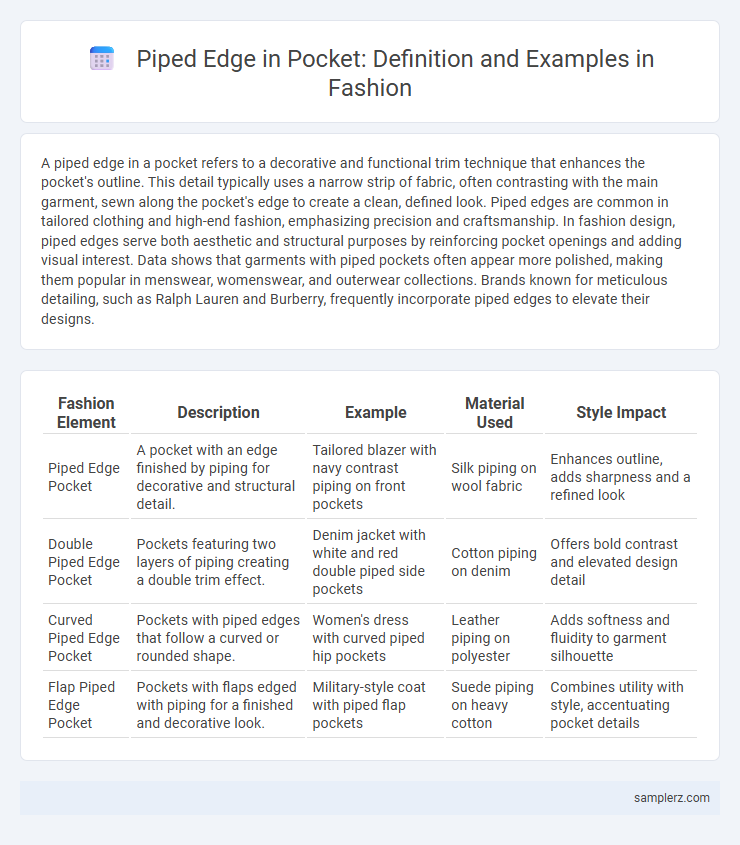A piped edge in a pocket refers to a decorative and functional trim technique that enhances the pocket's outline. This detail typically uses a narrow strip of fabric, often contrasting with the main garment, sewn along the pocket's edge to create a clean, defined look. Piped edges are common in tailored clothing and high-end fashion, emphasizing precision and craftsmanship. In fashion design, piped edges serve both aesthetic and structural purposes by reinforcing pocket openings and adding visual interest. Data shows that garments with piped pockets often appear more polished, making them popular in menswear, womenswear, and outerwear collections. Brands known for meticulous detailing, such as Ralph Lauren and Burberry, frequently incorporate piped edges to elevate their designs.
Table of Comparison
| Fashion Element | Description | Example | Material Used | Style Impact |
|---|---|---|---|---|
| Piped Edge Pocket | A pocket with an edge finished by piping for decorative and structural detail. | Tailored blazer with navy contrast piping on front pockets | Silk piping on wool fabric | Enhances outline, adds sharpness and a refined look |
| Double Piped Edge Pocket | Pockets featuring two layers of piping creating a double trim effect. | Denim jacket with white and red double piped side pockets | Cotton piping on denim | Offers bold contrast and elevated design detail |
| Curved Piped Edge Pocket | Pockets with piped edges that follow a curved or rounded shape. | Women's dress with curved piped hip pockets | Leather piping on polyester | Adds softness and fluidity to garment silhouette |
| Flap Piped Edge Pocket | Pockets with flaps edged with piping for a finished and decorative look. | Military-style coat with piped flap pockets | Suede piping on heavy cotton | Combines utility with style, accentuating pocket details |
Introduction to Piped Edge Pockets in Fashion
Piped edge pockets in fashion feature a distinct, narrow fabric trim sewn along the pocket's opening, providing a clean, tailored finish. This design element enhances garment structure and durability while adding subtle decorative contrast, often seen in tailored jackets and trousers. Incorporating piped edges into pockets emphasizes craftsmanship and elevates the overall aesthetic of high-end fashion pieces.
Classic Designs Featuring Piped Edge Pockets
Classic designs featuring piped edge pockets often showcase tailored blazers and trench coats where the distinct piping adds a refined contrast, highlighting the garment's structure. This detail enhances visual appeal by framing the pocket opening with sleek, often leather or fabric-wrapped cords, ensuring durability and a polished finish. Iconic brands like Burberry and Ralph Lauren frequently incorporate piped edge pockets to blend timeless elegance with subtle craftsmanship in their outerwear collections.
Materials Commonly Used for Piped Edges
Piped edges in pockets often utilize durable materials like cotton twill, leather, and grosgrain ribbon to create a structured and polished finish. These materials are chosen for their ability to maintain shape while adding contrast and texture to garments. Satin and velvet are also popular for luxury designs, offering a smooth, elegant accent that enhances pocket detailing.
Piped Edge Pocket Techniques in Tailoring
Piped edge pockets showcase precise tailoring techniques that involve inserting a narrow strip of fabric, or piping, along the pocket opening to create a clean, structured finish. This method enhances pocket durability and adds a decorative element that is both functional and stylish in garment design. Mastering piped edge pocket construction requires careful measurement and stitch accuracy to ensure seamless integration with the garment's silhouette.
Visual Appeal: Color Contrasts in Piped Edging
Piped edges in pocket design create striking visual appeal through color contrasts, enhancing garment detail by outlining pocket shapes with bold or complementary hues. For example, a black jacket with bright red piped pockets adds a vibrant focal point, drawing attention and elevating the outfit's overall style. This technique not only emphasizes pocket contours but also introduces dynamic texture and depth to fashion pieces.
Modern Fashion Brands Using Piped Edge Pockets
Modern fashion brands like Prada, Gucci, and Alexander McQueen frequently incorporate piped edge pockets to enhance garment detailing and elevate design sophistication. These pockets feature a distinct, narrow trim along the pocket opening, providing both structural integrity and a sleek visual contrast, often crafted from contrasting fabrics or leather. This design element is favored in contemporary collections for its ability to blend functionality with high-end aesthetics, fitting seamlessly into minimalist or avant-garde styles.
Step-by-Step Example of Sewing a Piped Pocket
Create a piped pocket by first cutting the pocket and piping fabric to your desired size and shape. Attach the piping by sewing it along the edge of the pocket piece, ensuring the piping cord is evenly enclosed for a clean, raised finish. Finally, sew the pocket onto the garment body, securing the piped edges for a polished and professional look in fashion design.
Piped Edge Pockets in Men’s vs. Women’s Wear
Piped edge pockets in men's wear often feature structured, narrow piping along the pocket opening, emphasizing sharp, tailored lines for a polished look. In women's wear, these pockets commonly showcase softer or decorative piping, enhancing femininity while maintaining functional appeal. The contrast highlights how piped edge pockets adapt to gender-specific design preferences, balancing style and utility.
Benefits of Adding Piped Edges to Pockets
Piped edges on pockets enhance durability by reinforcing the pocket's opening, preventing wear and tear over time. They add a tailored, polished look that elevates the garment's overall aesthetic and detail. This design feature also provides structural support, maintaining the pocket's shape and functionality through frequent use.
Care Tips for Garments with Piped Edge Pockets
Garments with piped edge pockets require gentle handling to preserve the crispness of the edging. Hand washing or using a delicate cycle with mild detergent prevents fraying along the piping and maintains the pocket's firm structure. Avoid excessive heat during drying by air drying flat, which helps retain the garment's shape and the sharpness of the piped edges.

example of piped edge in pocket Infographic
 samplerz.com
samplerz.com